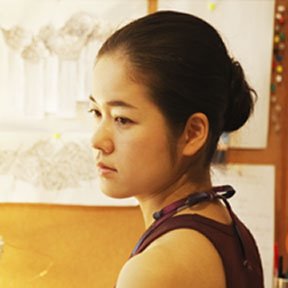ART REVIEW: The Star-Ledger

The Star-Ledge
ART REVIEW: At Aljira, reasons to be playful
BY DAN BISCHOFF
Published:Sunday, July 29, 2007
Anybody who's seen the shows at the Jersey City Museum knows curator Rocio Aranda-Alvarado likes to assemble art exhibits with a puckish sense of humor. But when Aranda-Alvarado was asked to guest curate the "Emerge 8" exhibit at Aljira in Newark, a show done each year for the alternative gallery's professional development seminar, we really had no reason to think it, too, would be a corker.
But it is. There's a concrete block painted a dark, royal blue, for example, and one right next to it made entirely of Cheetos, a brighter orange than any traffic cone, by Mike Womack (the doodles are held together with clear resin -- makes them more appetizing, too). In the front window of the gallery, artist Julie Peppito has constructed four different dragonflies out of little boys' toys, plastic kittens, bowling trophy figures, Xmas ornaments, snow globes, etc. Suzanne Broughel has built a brick wall out of white bars of soap punctuated by a hole in the middle made out of ovoid bars of black soap, making you think of how the white wall would collapse if the black bricks were removed; all the soap, she explains, was bought from black-owned businesses located right around the Aljira storefront.
Okay, if that's not funny enough, check out Patrick Grenier's "The Whitney Museum Searching Cultural Desert for Artists," a video mounted in a frame that looks like the slanted rhomboidal window at the center of Marcel Breuer's museum façade. In the video, you see a boxy version of Breuer's cantilevered museum design mounted on the wheels of a remote-controlled electric car moving through a landscape, looking remarkably like the weird boxy landship driven by the Sand People in the first "Star Wars" movie (it is even shot silhouetted against a brilliant orange sunset, as was the landship when R2-D2 was first carried into it). Which would make the Whitney museum folks equivalent to the Sand People, combing the wastelands for fragments of techno-junk they can then buff up and resell for a profit, beachcombers, really. ...
"It's true that most of these artists don't take themselves or their work too seriously, so they can be playful," Aranda-Alvarado says. "This is the first time I've curated a show of artists whom I did not choose myself, with a predetermined theme. So I went to each one and asked them to give me what they thought was their best work -- and I think that's what makes the show work. It wasn't entirely me fitting them into some concept, but each artist getting enthusiastic about choosing the piece that would satisfy me, too."
All 20 artists enrolled in the Emerge 8 program were taught useful skills, like how to present work to a gallery, how to work out a meaningful financial profile, and how to generate publicity about their work. They range in age from the early 20s to some in their 40s and 50s ("emerging artist" is a term usually applied to recent art school grads, but the art world often seems more and more to be filled with older artists who are finding an audience in their middle years or later, and Aljira's Emerge is intended to serve all ages). This exhibition is the ultimate reward for taking part.
But it has been striking to see the remarkable range and extraordinary talent of so many artists in this particular program over the past few years, whether it's because Emerge has become better known or just because the talent pool of visual artists is so much deeper than we ever imagine. And this show is no exception.
Elisabeth Smolarz's "Freund Hein," a projection of six simultaneous videos in two rows, showing people in a full-body shot standing straight then suddenly performing their version of dying. (Some cough and then slump to the ground, others carefully sit and lie down -- a number of the men, if they're young enough, take a cue from boyhood and pretend to be shot, à la Robert Longo's famous charcoal "Falling Yuppies.") Smolarz shot the videos with volunteers when she was working as an artist in residence at the Rotunda Gallery in Brooklyn.
Even when the art isn't LOL, it has a cheeky insouciance.
Jenny Polak has pinpointed on a digital map of the U.S. all the sites in the last year where the Immigration Service has conducted raids, giving the number of illegals arrested and deported and the name of the business that employed them. On the wall above the computer she hangs small ovals painted a teal blue (a color often used in public service signage in the 1950s-'60s) on which she has sketched the various on-site jobs that the illegals were doing--like "Janitorial," "Security Guard," "Oil Refinery." Her title is "Return to Sender: Raided Worksites, 2006-7."
And again, the quality of the craftsmanship is amazing, like Natsu's "Mushiki Whale-Cosmic Egg," a glittery construction made of brass wire and plastic beads as big as a motorbike that is suspended from the ceiling in the center of the gallery. The most jaw-dropping is Alisoun Meehan's nine-foot-long pastel of a Chinese restaurant window, called "Open Neon" (2006). Not photo-realist, exactly, but Meehan is a poet with orange and red, and the whole thing is really a reflection in a sheet of safety glass, so it is maddeningly subtle to read --but you have to see it in person to really get it.
Maybe it's not funny, but it will make you happy for a while.
Emerge 8
Where: Aljira, a Center for Contemporary Art, 591 Broad St., NewarkWhen: Through Sept. 29. Noon-6 p.m. Wednesdays-Fridays; 11 a.m.-4 p.m. SaturdaysHow much: A donation of $5 is suggested. Call (973) 622-1600 or contact info@aljira.org.


<< Home